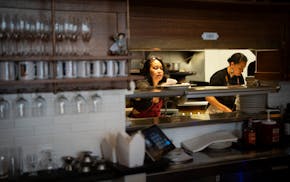It's the world's most coveted honor for restaurants, and if the Minneapolis Downtown Council has its way, the city might finally get the chance to earn Michelin stars.
As a part of the Downtown Council's 2035 Plan to revitalize the city, CEO Adam Duininck will include an effort to woo the Michelin Guide to the Mill City. Duininck previewed the plan at a Financial Executives International Twin Cities event on Oct. 9 as part of a multifaceted plan to bolster the city's downtown, as reported in the Minneapolis/St. Paul Business Journal.
But what does it mean?
The Michelin Guide lists more than 30,000 restaurants worldwide with star ratings of one to three as recommended dining destinations that are generally regarded as the best of the best in the world of great eating. Fewer than 300 U.S. restaurants have been awarded Michelin stars; the closest to Minnesota are Chicago, with more than 20, and Denver, with 4.
With Twin Cities chefs and restaurants getting national attention, it might seem strange that we haven't yet appeared in the guide. The reason why is a simple one: money. Cities, states and counties reportedly pay hundreds of thousands of dollars to bring the guide into their restaurants.
According to a report in the New York Times, the dollar amounts spent to entice Michelin to inspect their regions was significant. The Times found that Visit California paid $600,000, while the Colorado Tourism Office spent $300,000 to have restaurants in Denver, Boulder, Aspen, Vail, Snowmass and Beaver Creek considered for stars.
Several Twin Cities restaurants and chefs already boast plenty of national acclaim, including James Beard Awards, Time magazine's people of the year, and mentions in "best of" lists from Food & Wine, Bon Appétit and the New York Times.
The Michelin Guide remains an enticing recognition with a dedicated global audience with a singular goal of dining at restaurants featured in the iconic guide. It's an allure understood by the Minnesota Star Tribune's restaurant critic Jon Cheng, who wrote of paging through the distinctive red book as a child "as if it were a bible, because I carried it with me every time I visited a city that the Michelin Guide deemed worthy."
Perhaps it's not entirely surprising that the guide requires a certain investment in placement considering it begin as a way to move product. Founded in 1889 in central France, brothers Andre and Edouard Michelin produced a small guide to encourage motorists who bought their company's tires to travel more by telling them where to stay and eat. In 1920, the company began charging people money for access to the guide and a tradition was born, rising alongside the popularity of car culture.
While the Michelin Guide has also introduced its Bib Gourmand Awards, designations for more economically attainable eateries, and lists other restaurants in its guide, the dining at starred restaurants is usually regarded as an elite experience. (Michelin awards restaurants one to three stars.)
And Minneapolis chefs have experience moving in Michelin circles. Adam Ritter of Bucheronworked at the once-closed but now reopened two-starred Cyrus in California, before moving to Minnesota. Erik Anderson, who led the kitchen at Sea Change and opened Grand Cafewith Jamie Malone, left the city to work at several highly reviewed restaurants across the country and pulled in two Michelin stars during his time at San Francisco's Coi. Gavin Kaysen earned a Michelin star during his tenure leading the kitchen at New York's Cafe Boulud before shocking the culinary community by moving back to his home state of Minnesota.
Critics have said that Kaysen's North Loop restaurant Demi would be an obvious draw for Michelin inspectors. In an effort to raise Minnesota's profile in the eyes of the guide, Kaysen has often invited chefs who have received the honor to cook in his restaurants for special ticketed events.
Whether the Downtown Council's plan to bring the guide here will be successful remains to be seen — this was just Duininck's preview with no dollar amounts or specifics released.
But it does raise more questions. If the council's bid were to be successful, would that mean that only Minneapolis restaurants would be given consideration? Would St. Paul join the effort with dollars of its own? What about all the outstate dining that deserves a spotlight?
Stay tuned; we will update this story as it develops.

Can a prison be beautiful? And should it?

Immigrant home cooks shine in new Twin Cities dinner series

Broders won't reopen Terzo restaurant in Minneapolis after flooding

Afghan allies struggle in Minnesota after funding cuts: 'What will I do?'
